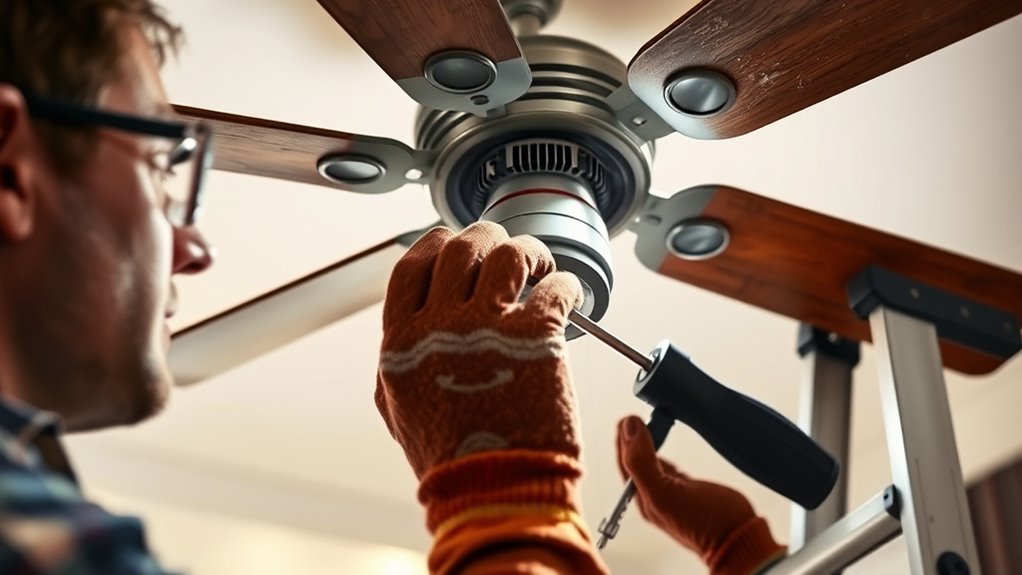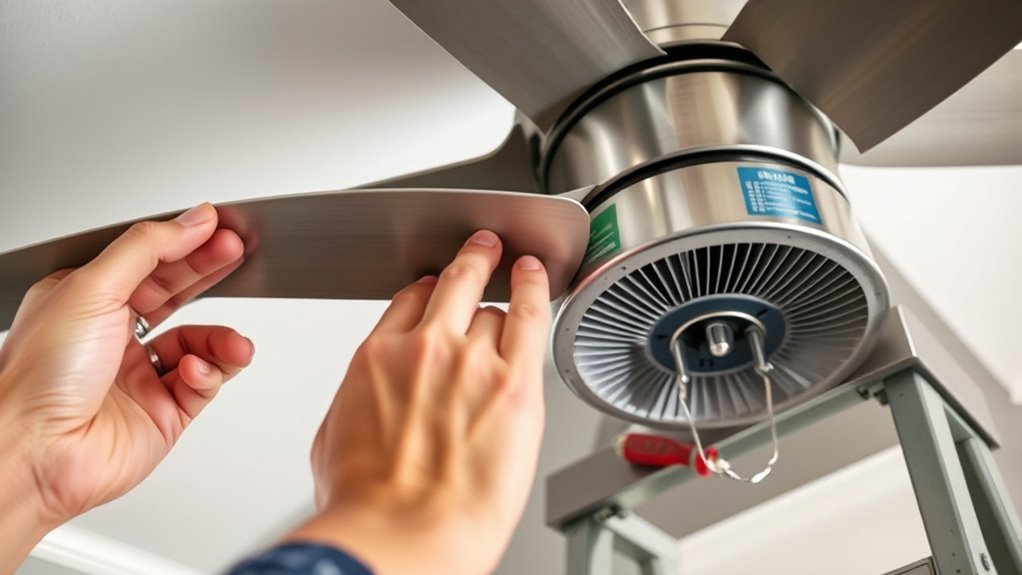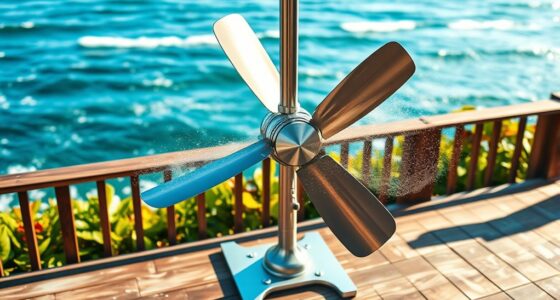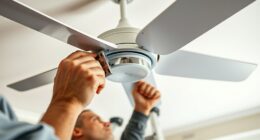To diagnose ceiling fan noise, begin by inspecting the blades for warping or dust buildup and guarantee they are securely attached and properly balanced. Check the mounting hardware for looseness and tighten if needed. Test electrical components like capacitors and wiring for faults, replacing any defective parts. Lubricate motor bearings and verify the fan operates smoothly at various speeds. If persistent noise remains, further adjustments or component replacements may be necessary, and detailed steps are provided if you continue.
Key Takeaways
- Inspect and tighten mounting hardware and blades to eliminate wobbling and imbalance-related noise.
- Check and replace damaged or warped blades for smooth operation and reduced vibration.
- Test and replace faulty capacitors or worn motor bearings to prevent humming and grinding sounds.
- Ensure electrical connections are secure and switches or control modules are functioning correctly.
- Perform regular maintenance, including cleaning blades and lubricating motor parts, to minimize noise over time.

Ceiling fan noise issues can substantially disrupt comfort and concentration, often indicating underlying mechanical or electrical problems. Identifying the root cause requires a systematic approach to diagnosing both structural and operational components. Begin by inspecting the mounting hardware. Loose brackets or screws can cause vibrations that produce rattling or humming sounds. Use a torque wrench to tighten all mounting screws securely, ensuring the fan is firmly affixed to the ceiling. Check for any wobbling, which may signal an imbalance or misalignment. If the blades are uneven or warped, this will generate additional noise during operation. Use a balancing kit if necessary to correct blade alignment, and consider replacing any damaged blades to restore smooth, quiet operation.
Inspect mounting hardware and blades to resolve ceiling fan noise issues effectively.
Next, focus on the blades and their attachments. Over time, dust or debris can accumulate on the blades, creating uneven surfaces that lead to noise when the fan spins. Clean the blades thoroughly with a damp cloth, removing dust and grease. Verify that each blade is securely attached to the hub; loose blades can cause vibrations and noise. Tighten blade screws, but avoid overtightening, which could cause cracks or deformation. If a blade is cracked or warped beyond repair, replacing it ensures proper balance and reduces noise.
Electrical components also play a significant role in noise generation. Faulty or aged capacitors can produce a humming or buzzing sound during operation. If you hear persistent electrical noise, consider testing the capacitor with a multimeter designed for capacitance measurement. Replacing a defective capacitor with a manufacturer-approved part can eliminate electrical humming. Similarly, worn or damaged motor bearings can produce grinding or squealing sounds. In this case, the motor may require lubrication or bearing replacement. Use a high-quality, manufacturer-recommended lubricant, applying it to the motor shaft and bearing assembly to reduce friction and noise. If bearings are severely worn, replacing the entire motor assembly might be necessary to achieve peaceful quietness.
Furthermore, modern ceiling fans often incorporate heat pump technology to improve energy efficiency and reduce operational noise, so ensure your fan’s components are compatible with current noise-reduction features. Finally, consider the switch and control system. Malfunctioning switches or remote controls can cause irregular operation or humming sounds. Inspect wiring connections for signs of wear, corrosion, or loose connections. Tighten any loose wires, and replace damaged switches or control modules to ensure stable electrical flow. If noise persists after addressing mechanical and electrical issues, test the fan’s operation at different speeds. Sometimes, specific speed settings cause vibrations or humming, which can be mitigated by adjusting the fan’s control device or replacing the speed control module.
Frequently Asked Questions
Can Ceiling Fan Noise Cause Electrical Fires?
Ceiling fan noise itself doesn’t directly cause electrical fires, but it can signal underlying issues that might. Loose wiring, faulty components, or overheating motors, which often generate noise, increase fire risks if neglected. You should regularly inspect your fan for signs of wear or damage, verify all connections are secure, and replace any worn parts promptly. Addressing these issues reduces fire hazards and maintains safe, quiet operation.
Are There Eco-Friendly Solutions for Noisy Fans?
Yes, there are eco-friendly solutions for noisy fans. You can opt for energy-efficient fans with sustainable materials, reducing environmental impact and noise levels simultaneously. Regularly cleaning and lubricating fans prevents excess energy use and minimizes noise. Installing fans with advanced aerodynamics and eco-conscious components guarantees quiet, efficient operation. Additionally, choosing fans with certified green standards supports environmentally responsible manufacturing, aligning noise reduction with ecological sustainability.
How Often Should I Lubricate My Ceiling Fan?
You should lubricate your ceiling fan every 6 to 12 months to maintain peak performance. Use a light machine oil or a lubricant recommended by the manufacturer, applying it to the fan’s motor and blade bearings. Turn off the fan and verify it’s completely stationary before lubrication. Regular maintenance prevents friction buildup, reduces noise, and prolongs the fan’s lifespan. Frequency may vary based on usage and environmental conditions.
Can DIY Fixes Void My Ceiling Fan Warranty?
Yes, DIY fixes can void your ceiling fan warranty if they involve disassembling or modifying parts covered under the warranty terms. Manufacturers typically specify that only authorized technicians or service providers should perform repairs or maintenance. To avoid voiding your warranty, consult the manufacturer’s guidelines or contact professional service providers before attempting any repairs yourself. Always keep documentation of professional repairs to retain warranty coverage validity.
Is It Safe to Operate a Noisy Ceiling Fan?
Yes, it’s safe to operate a noisy ceiling fan if you’re cautious. Persistent, loud noises can indicate underlying issues like loose blades, worn bearings, or imbalance, which may worsen over time. You should promptly inspect the fan for visible defects, tighten loose parts, or replace faulty components. If the noise continues or if you’re unsure, turn off the fan and consult a professional technician to prevent potential damage or safety hazards.
Conclusion
By systematically diagnosing and addressing each noise source, you can restore your ceiling fan to a smooth, silent whirl. Think of it as tuning a finely crafted instrument—tightening loose components and balancing blades ensures harmony. When you identify the culprit, whether it’s a wobble or vibration, you’re fundamentally silencing the discord. With precise adjustments, your fan becomes a steady, whispering breeze rather than a disruptive buzz, restoring comfort and peace to your space.









